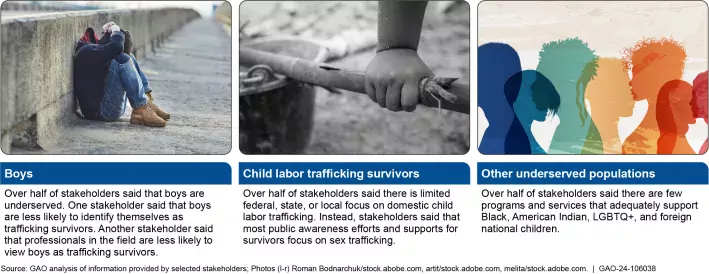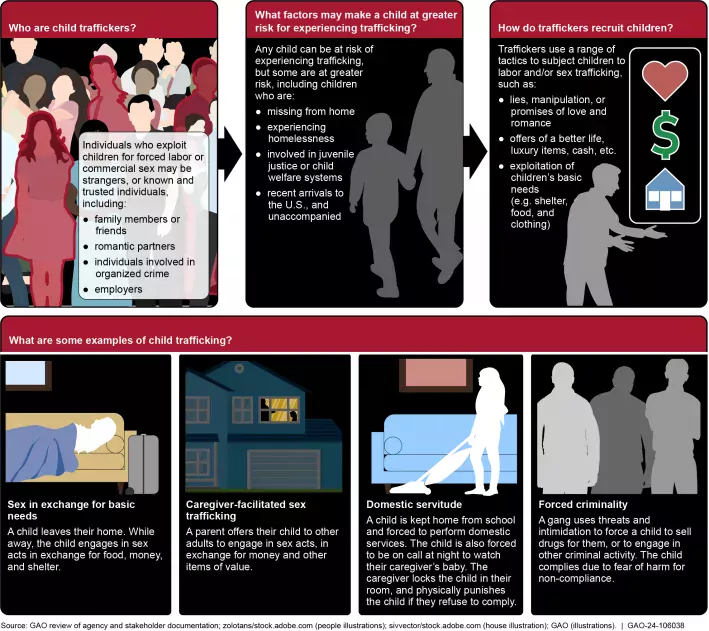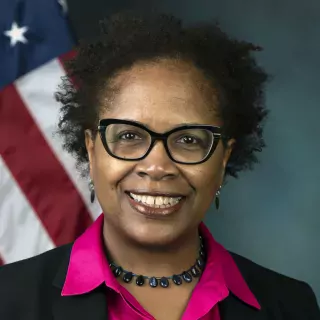Misperceptions Can Make It Harder to Prevent Child Trafficking and Help Survivors
Child trafficking is a horrific crime. Traffickers can target children due to their age and vulnerability and exploit them sexually, force them to work, or both.
Federal, state, and local governments, as well as non-governmental organizations, are working to raise awareness and help survivors of these crimes. But common misperceptions about child trafficking can hinder these efforts and the support survivors receive.
Today’s WatchBlog post looks at our new report—a Q&A—on misperceptions and other challenges related to child trafficking, as well as federal efforts to address it.
Image

Misperceptions about child trafficking
Some may think of child trafficking as situations involving strangers kidnapping children off the street. But trafficking happens in many different places, by many different means. For example, traffickers often connect with kids online. Children may also be trafficked in their homes or by trusted adults, including family members or caregivers.
This is just one misperception. For our new report, we interviewed stakeholders (some who work to raise public awareness and support survivors) about other misperceptions related to child trafficking. For example, these stakeholders told us that:
- While Black girls are overrepresented in incidents, the public may be less likely to view Black girls as trafficking victims/survivors—possibly due to limited representation of Black girls in public awareness materials.
- Because individuals may think of child trafficking as only involving children who have been kidnapped or forced into trafficking, they may “victim blame” children in other types of trafficking situations. For example, one stakeholder told us that individuals may view children who engaged in sex acts in exchange for shelter as making a choice to be in that situation.
- Sometimes organizations that provide services to survivors do not understand common situations of children being trafficked. For example, some children may get addicted to illicit substances through their traffickers. However, some service providers may prohibit services for children with substance use issues, so these children may not get the support they need.
Overview and Examples of Child Trafficking
Image

How misperceptions limit awareness and efforts to help survivors
Misperceptions about child trafficking can harm efforts to raise public awareness and support survivors. For example, one way communities can help recognize and respond to these crimes is through local school systems. But the Department of Health and Human Services reported that one of its programs sometimes had difficulty obtaining school administration agreement to offer preventative education to educators and students. HHS said that this is due in part to some school administrators’ reluctance to accept that child trafficking can occur within their communities.
More than half of the stakeholders we spoke with reported similar challenges. They said that limited training for professionals who may interact with survivors—such as teachers and law enforcement officials—makes it hard to raise awareness or to identify potential cases.
Other challenges that limit efforts to help survivors
Some state and local criminal justice systems may not identify survivors as victims, and instead punish them for their trafficking experiences, according to Department of Justice officials. Stakeholders also told us that children in some jurisdictions may be placed in juvenile detention for prostitution, theft, or other actions that occurred while they were trafficked. When detained, these children may not receive the services they need to address their experience with trafficking.
Our new report discusses these misperceptions, their impacts, and other challenges, as well as federal efforts to address these crimes. We have also made recommendations to help improve federal efforts. Learn more by reading our new Q&A report.
- GAO’s fact-based, nonpartisan information helps Congress and federal agencies improve government. The WatchBlog lets us contextualize GAO’s work a little more for the public. Check out more of our posts at GAO.gov/blog.
GAO Contacts
Related Products

GAO's mission is to provide Congress with fact-based, nonpartisan information that can help improve federal government performance and ensure accountability for the benefit of the American people. GAO launched its WatchBlog in January, 2014, as part of its continuing effort to reach its audiences—Congress and the American people—where they are currently looking for information.
The blog format allows GAO to provide a little more context about its work than it can offer on its other social media platforms. Posts will tie GAO work to current events and the news; show how GAO’s work is affecting agencies or legislation; highlight reports, testimonies, and issue areas where GAO does work; and provide information about GAO itself, among other things.
Please send any feedback on GAO's WatchBlog to blog@gao.gov.





